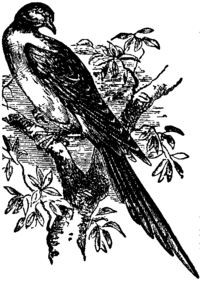The New Student's Reference Work/Pigeon

|
| PASSENGER-PIGEON |
Pigeon (pĭ′jŭn), a name for members of the dove family. There are about 300 species all over the world, being most abundant in the East Indies. Only two are found in the Eastern United States — the wild pigeon and the turtledove. The wild or passenger-pigeon is exceedingly rare. It formerly was very abundant, perching in the forests in such numbers as to break limbs of trees and covering a large territory in their daily flight in search of food. During migration they flew in such large flocks that it would sometimes require days for them to pass a particular point. They were nearly exterminated by wholesale slaughter. The bird is about 17 inches long, with large wings and a long, pointed tail. The male is bluish above, purple brownish-red below, more violet behind, with a black bill and yellow feet. It depended largely upon acorns and beechnuts for food, with occasional feasts on grain and berries. The turtle or mourning dove still is quite common. The long, soft, mournful note of the male during the nesting season is known to nearly everyone in the United States. It is a smaller bird than the passenger pigeon, being about 11¾ inches long. The upper parts are olive grayish brown, the neck iridescent, the breast pinkish and the belly buff; the outer tail-feathers are tipped with white. They nest in isolated pairs, and two broods are produced a year. There is a large number of domestic pigeons, all descended from a wild form generally believed to be the blue rock-pigeon; but there is reason to doubt this. Pigeon-breeding has been engaged in throughout Europe and eastern countries for centuries. It is a favorite pastime in the United States. A great range of variation has been produced by breeding. Some of the more conspicuous varieties are the fan-tail with large spreading tail; the pouter, with inflated breast; the tumbler; carrier; trumpeter; barb; and jacobin. Darwin made use of pigeons in observing the changes produced in animals under domestication, through the influence of artificial selection. The breed which is called the carrier pigeon, or the homing pigeon, is employed for carrying messages. There is no real distinction between doves and pigeons.